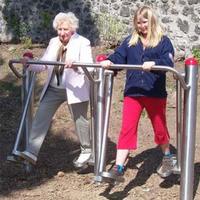Increased longevity has provided many opportunities for different generations to come together. Creating environments for harnessing the wisdom and experiences from these multiple generations can strengthen intergenerational relationships, which are crucial for the development of an age-inclusive society. To achieve such a society, we have to think hard about how old and young relate to each other in a wide variety of social spaces. The transformative nature of global ageing presents unique challenges only for researchers and decision makers but also on individual level to capture the richness of each generation
One solution to this challenge is the development of intergenerational programmes with a view to bringing people together from different generations, regardless of familial relationships, through planned activities. Intergenerational programmes can be developed in various settings including: schools, nursing homes, universities, and community centres. Although most programmes occur indoors, intergenerational programmes can also happen in public spaces like city parks. In fact, one can argue that the main purpose of a city park is to promote social integration. Since a city park is already a space for multigenerational usage, with innovative design of the physical landscape we can encourage these generations to mingle and socialize, thus, promoting greater intergenerational dialogue and interaction.
However, in reality, public spaces, like city parks, are seldom used to promote intergenerational relationships. When we look carefully at the spaces and activities in city parks, we can readily spot many age-specific activities that exacerbate age-based segregation. For example, while children mostly occupy the playgrounds and young people to use the sport fields, many older adults are left with sitting around benches and using gymnastic equipment. Thang (2015) developed the concept of an intergenerational contact zone (ICZ) defined as a physical place for all generations to meet, interact and relate to each other. City parks as ICZ are meant to be places of meaning and opportunity through the experience of sharing common public spaces.
In order to answer my question of how to take advantage of an open space to design a city park that promotes intergenerational relationships, we need to consider the programme’s design in the wider context. The physical location plays a crucial role fostering of intergenerational relationships. The literature highlights some good practices for city parks to promote intergenerational programmes (Vieira & Guerra, 2012; Thang, 2015; Delgado-Acosta, Calero-Martín & González-Bencomo, 2016). I propose the following three actions to challenge our current public use of park spaces in order to promote the use of intergenerational programmes:
- Action no. 1: Regular intergenerational activities
Since city parks are already used by different generations, municipal governments and stakeholders should take more active roles in developing regularly intergenerational activities for people of all ages to coexist, exchange experiences, learn together and share knowledge.
- Action no. 2: Mechanisms for continuing community participation
The continuance of community feedback is vital for realizing a sustainable vision of local parks as intergenerational engagement hubs. Even after the programme’s planning and (re)development process has been completed, it is crucial to kept in place innovative and participative instruments to readapt initiatives to people’s needs.
- Action no. 3: Creation of common leisure areas through parks design
It is important to rethink the design and geography of city parks in order to facilitate the interaction of all generations through common leisure areas. Such designs should accommodate the needs and uses for all generations and promote intergenerational interactions.
This layout of city parks reflects the organization of modern societies where goods and services are also typically organised by age-segregation silos. To promote better intergenerational cohesion, it is necessary to be more efficient in organizing spaces in order to minimise conflict and services delivery. This requires one to rethink the structure of our societies in order to avoid intergenerational tension and perpetuation of age-based segregation.
References
Delgado-Acosta, C., Calero-Martín , C., & González-Bencomo, H. (2016). Potencialidad de los espacios públicos abiertos para las relaciones intergeracionales. Un estudio de caso en la ciudad de Santa Cruz de Tenerife (Canarias, España). Documents d´Análisi Geográfica, vol62/1, 5-25.
Vieira, S. & Guerra, S. (2012). Revitalizing city parks through intergenerational activities: The Park Infante Dom Pedro, city of Aveiro, Portugal. Revista Temática Kairós Gerontologia, 15(1), 135-152.
Thang, L.L. (2015). Creating an intergenerational contact zone: Encounters in public spaces within Singapore’s public housing neighbourhoods. In R. Vanderbeck & N. Worth (Eds.). Intergenerational spaces (pp. 17-32). London, UK: Routledge.
About the Author:
Cláudia Azevedo is a Visiting Fellow at the Oxford Institute of Population Ageing and the Research Officer for LARNA (Latin American Research Network on Ageing. Claudia is PhD student from Porto University, Portugal
Opinions of the blogger is their own and not endorsed by the Institute
Comments Welcome: We welcome your comments on this or any of the Institute's blog posts. Please feel free to email comments to be posted on your behalf to administrator@ageing.ox.ac.uk or use the Disqus facility linked below.













